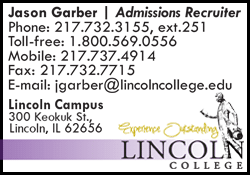|
Let Social Security help guide you to work
By Becky
Whitlow, Social Security district manager in
Springfield
 Send a link to a friend
Send a link to a friend
[September 05, 2013]
SPRINGFIELD -- September is
National Guide Dog Month. The celebration of the work that guide
dogs do each day was inspired by actor Dick Van Patten, who wanted
to raise awareness and money for guide dog schools.
|
 Many people who depend on guide dogs also depend on disability
benefits. People who receive Social Security or Supplemental
Security Income due to a disability suffer from severe ailments that
make them unable to work and provide for themselves. However,
sometimes it is possible -- with a little help -- for people with
disabilities to become self-sufficient through work. Many people who depend on guide dogs also depend on disability
benefits. People who receive Social Security or Supplemental
Security Income due to a disability suffer from severe ailments that
make them unable to work and provide for themselves. However,
sometimes it is possible -- with a little help -- for people with
disabilities to become self-sufficient through work.
If you are getting disability benefits, the Social Security staff
understands how difficult the prospect of trying to work can be. We
also understand that the possibility of having medical and financial
benefits cut off can be frightening. But rest assured, Social
Security has some great work incentives in place that allow people
with disabilities to "test the waters" and prove that they can work
before any benefits are stopped. That makes it inviting to try. Even
if things don't work out, the benefits will still be there for you.

These work incentives include continued cash benefits for a
period of time while you work, continued Medicare or Medicaid while
you work, and help with education, training and rehabilitation to
start a new line of work. The rules vary depending on whether you
receive Social Security or SSI.
Although the ultimate goal of work incentives is to help bridge
the gap between a dependence on monthly benefits and
self-sufficiency, Social Security casts a large safety net to make
sure you do not find yourself in dangerous waters. You may continue
to receive benefits while working, and medical benefits can
sometimes continue to provide coverage for years.
[to top of second column] |

When a person who receives Social Security or SSI disability
benefits works, there are certain impairment-related work expenses
that are deducted from your countable income, making it possible to
earn more and remain eligible to receive benefits. For SSI, these
excluded expenses can allow you to receive a higher benefit payment.
Examples of these impairment-related work expenses include
wheelchairs, certain transportation costs and specialized
work-related equipment. Work expenses for the blind can include
guide dog expenses, meals consumed during work hours and income used
to pay income taxes.
You can learn all about the different rules for both Social
Security and SSI in the publication "Working While Disabled -- How
We Can Help," available to read or listen to at
www.socialsecurity.gov/pubs. From that page, type the title in
the box at the left side of the page. The online booklet will tell
you about the work incentives you may be able to use.
You also can put the word "work" in the publications search box
to find out more about how Social Security's work incentives can
help you. Pay special attention to the publications entitled
"Incentives to Help You Return to Work" and "Your Ticket to Work."
These publications, which you can read or listen to, will guide you
as you consider your options.
[By BECKY WHITLOW,
Social Security district manager in Springfield]
 |